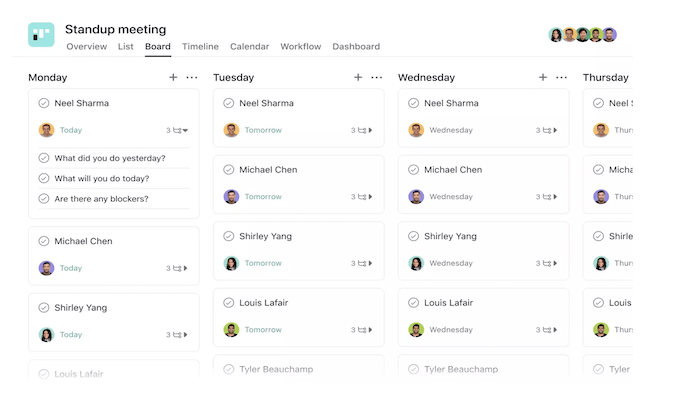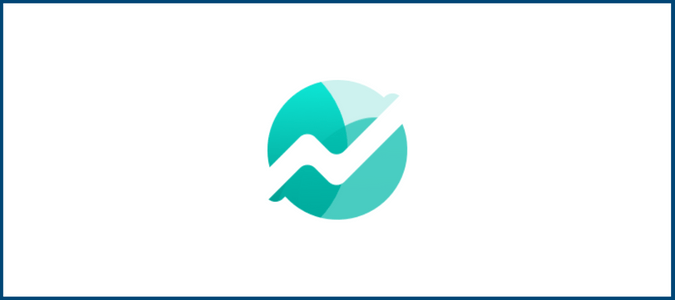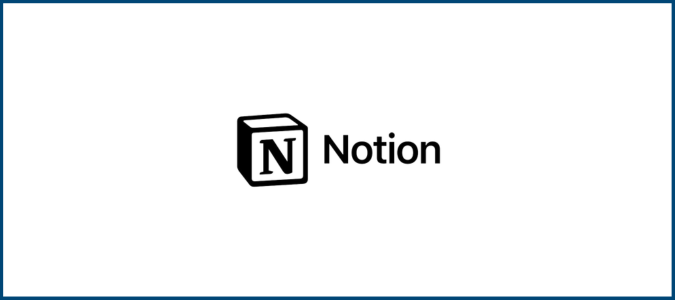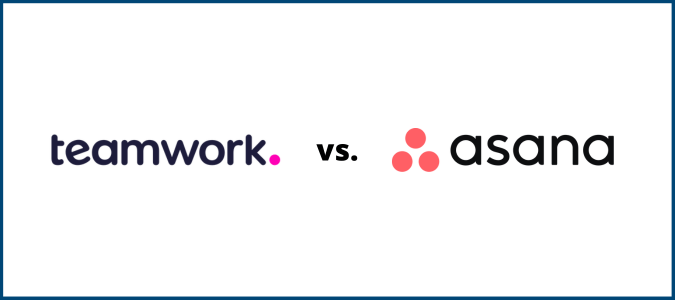Agile project management is a versatile methodology that can be applied to a wide range of project types, industries, and teams. Finding the right template is crucial, as it gives project managers a repeatable formula for success.
But there are so many variations within the Agile framework—meaning there are lots of different templates to consider. Continue below to view some solid examples of templates that can be used for different Agile project types and find one that fits your team and goals.
1. Agile Project Plan Template by Smartsheet

Smartsheet is a complete work management solution that can be used for project planning, document sharing, and team collaboration. It’s essentially a more advanced version of other spreadsheets you’ve used in the past, like Excel or Sheets.
This template is a very basic Agile project planning solution that breaks a sprint down to different features, items, or deliverables that need to be completed. Add tasks, assign responsibilities, and choose start and end dates for each task in sheet form. Then you can update the status to get an accurate timeline of the project.
This template also comes with a Gantt chart view of the project, which is helpful for keeping mindful of due dates and other deadlines.
There are two different variations of the template. You can download the template for Excel or use it within Smartsheet’s platform. The Excel template will be a bit more limited, and you’ll have to update a lot more of the records manually. But if you access the template within Smartsheet, you’ll also benefit from the team collaboration features and workflow automations.
2. Agile Standup Meeting Template by Asana

Standup meetings are a key aspect of the Agile PM philosophy.
These meetings are held daily for roughly 15 minutes, usually at the start of the workday, to give the entire team an opportunity to share updates and get on the same page. Everyone reports on what they’ve accomplished and what they’re working on, plus if anything is blocking them from moving forward.
The term “standup meeting” is based on the concept that the entire project team is in the same room, and these meetings are supposed to be so short that it’s unnecessary for anyone to sit down.
But many Agile teams are dispersed, often working remotely from different locations and even different time zones. This makes daily standup meetings a bit more difficult to organize.
Fortunately, Asana has a standup meeting board view within its Agile project plan template. It’s a way to organize a virtual huddle for everyone on the team. You can use it to either supplement a regular standup video call or as a standalone means for members to share their updates without having to coordinate a 15-minute live call each day.
If team members have blockers or need assistance from the project manager or another teammate, they can simply add a message on a card and tag relevant users.
The cool part about using this template within Asana is that you can share documents and add attachments directly to tasks.
3. Product Roadmap Template by Miro

Miro has an excellent product roadmap template that works really well for development projects. This template simplifies the scope of large-scale projects, helping to break down and visualize short-term tasks that are important elements of the big-picture end game.
If you’re working on a project that involves multiple teams and stakeholders, this template will help keep everything organized. Each team can focus on what they need to own and prioritize rather than getting caught up in tasks that aren’t their responsibility.
To use this template effectively, you need to start with your strategy. Define your goals and clearly identify the “why” for the project.
From there, you can break up which teams need to handle certain product features. This Miro template uses a great color-coding format so that each team can be identified by a unique color. Even if certain features have dependencies with other teams, the colors always make everyone’s responsibilities very clear.
Like most Agile project planning templates, Miro designed this to organize tasks into two-week sprints.
Miro also integrates with Jira, so you can use this template with Jira cards for advanced issue tracking. This works really well for development teams already using Jira to track and manage other issues.
4. Scrum Management Template by ClickUp

The Scrum framework is an integral part of the Agile project management methodology. Scrum puts a large emphasis on breaking down big projects into short sprints and prioritizes team collaboration, organization, frequent testing, and rapid development.
ClickUp delivers an Agile Scrum Management Template that puts all of these principles into action.
The template comes with 30 unique status updates for tasks, eliminating broad statuses that don’t truly tell the whole story. You’ll also get six different project views, custom fields, tagging capabilities, and workflow automation.
Agile teams can easily use this template to automate repeat actions and get more tasks done during each sprint.
ClickUp also offers pre-built lists for sprints, retrospectives, and backlogs.
5. Agile Transformation Roadmap Template by Miro

Created by Miro, this is one of the most unique Agile project plan templates we’ve found. It’s designed specifically for teams that are transitioning to Agile project management for the first time.
The template helps project teams and organizations alike as they move away from rigid project planning. It has elements designed to help people buy into Agile, even if they have some reservations about the change.
For example, the template focuses less on detailed-oriented deliverables. Instead, it simply organizes all of the to-do tasks in the backlog. The roadmap is also more iterative, as opposed to showing a restrictive, linear timeline.
Overall, it’s designed to help teams understand the big-picture outcomes of a project. This template embraces the moving parts of a project and lets everyone know that it’s not a disaster if things change along the way.
This is a popular choice for organizations that have historically used the waterfall methodology or are ready to transition from static processes to a project culture that’s more flexible.
Transitioning to Agile project planning can be a big move for teams and companies that are stuck in old ways. This template really helps ease the transition and explains everything really well for everyone involved. It’s beginner-friendly and designed to get buy-in from your entire team.
6. Agile Gantt Chart by Microsoft

Gantt charts are a popular type of board view for Agile projects. This is a visual to display how work gets completed over time in relation to how much time was planned for the work.
Agile project teams can use Gantt charts to quickly see whether projects are being completed on schedule or if the timeline needs to be adjusted.
If you’re looking for a Gantt chart that checks all of the boxes, you can download this one with Microsoft 365. It lets you easily add new tasks, start dates, and end dates, plus assign responsibilities to different team members.
Another great part about this template is the ability to create dependencies between tasks. If one particular task is taking longer than expected, all of its dependencies will be automatically adjusted. This is something that would otherwise be challenging to calculate manually. It also helps project managers allocate resources effectively on the fly.
It’s worth noting that this Agile template is best for organizations that are already using a Microsoft ecosystem for other business processes. If you’re already using Microsoft 365 for day-to-day work, tapping into this Gantt chart template is a no-brainer.
7. Agile User Story Template by Smartsheet

This Smartsheet template is perfect for planning Agile projects from the end-user’s perspective.
It’s especially useful for development teams that need to create features for a piece of software, but instead of focusing the end goals and work priorities on the features, focus on the user.
The idea is very straightforward. Each user story describes the type of user and what they want to do. Examples might include:
- As an event attendee, I want to invite my friends, so we can share this experience together.
- As an employee, I want access to my direct deposit information to change my bank account details without going through HR.
- As a manager, I want a simple way to collect employee feedback to better understand everyone’s needs.
Smartsheet lets you create these user stories and keeps everything organized on a list. Then, based on the story, each item can be passed to the development team to create a feature that addresses the user’s need.
This template is another great way to streamline and simplify cross-department collaboration. It keeps stakeholders and developers on the same page, as these two groups don’t always speak the same language.
Rather than project managers telling developers what type of feature to build, it’s easy to just explain what the final result needs to be. Then, the developers have more freedom to create the features accordingly, as opposed to just blindly creating a list of features without understanding the purpose.
8. Agile Board Template by Miro

Miro’s Agile Board Template is ideal for teams using Scrum or Kanban methods. It’s very simple but versatile enough to accommodate projects across a wide range of industries and use cases.
The template starts with a pre-built layout of columns and rows. Each column is used to represent the status of a task. A simple workflow would include a backlog column, an in-progress column, and a done column. But you could add, remove, or customize these according to your needs.
The rows can be used to segment team responsibilities, such as development, design, and marketing.
Every task in the template is represented by a sticky note. These notes can be assigned to individual team members, and those users can then move the notes through the flow while collaborating with their teammates.
This is an excellent way for cross-departmental transparency on a single board.
For example, let’s say you have a no-code development platform. One of the ways your team is using this template is to create new plugins for your marketplace. Once a task goes through the development cycle and is completed, it could be moved to the marketing row—signaling that the new plugin is ready to be shared and promoted on social media.
This template can be as simple or complex as you want to make it. Your team could stick with three basic columns for task statuses or create eight columns with more granularity.
9. Agile Product Backlog Template by Smartsheet

Creating a product backlog is an important step in every Agile project planning process. The purpose of the backlog is to help product owners track every feature that stakeholders want in the final product.
Rather than just creating a list of features, Smartsheet offers a template for building and managing product backlogs in a more advanced way.
With Agile project management, the backlog is constantly changing and improving. Anyone on the team can add something to the backlog, and it’s the product owner’s responsibility to assign priority levels to everything.
The template includes drop-down columns that go beyond the feature itself. There’s a place for the user story, priority level, status, and whether or not it’s ready for a sprint. Another cool part about this template is its ability to automatically calculate story points for each sprint based on how values are assigned to each task.















